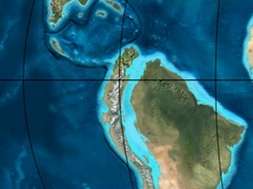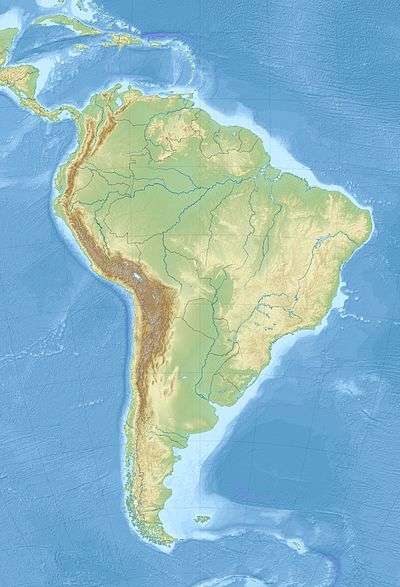Santa Lucía Formation
The Santa Lucía Formation is a Maastrichtian to Paleocene (Danian) geologic formation in Bolivia. Fossil ornithopod tracks have been reported from the Cretaceous lower part of the formation.[1] It is the type formation of the Tiupampan South American land mammal age.
| Santa Lucía Formation Stratigraphic range: Maastrichtian-Paleocene (typically Tiupampan) ~67–62 Ma | |
|---|---|
| Type | Geological formation |
| Unit of | Potosí Basin |
| Underlies | Cayara Formation |
| Overlies | El Molino Formation |
| Thickness | 381.35 m (1,251.1 ft) |
| Lithology | |
| Primary | Shale, marl |
| Other | Siltstone |
| Location | |
| Coordinates | 18°00′46.0″S 65°24′23.4″W |
| Region | Cochabamba |
| Country | |
| Type section | |
| Location | Tiupampa, Mizque |
| Coordinates | 18°00′46.0″S 65°24′23.4″W |
| Approximate paleocoordinates | 20.7°S 52.5°W |
 Santa Lucía Formation (Bolivia) | |
Description

65 Ma, by Ron Blakey
The Santa Lucía Formation is a formation of the Potosí Basin in Bolivia dated to the Paleocene, 60 to 58.2 Ma.[2] It overlies the Cretaceous El Molino Formation and is overlain by the Cayara Formation. The formation is laterally equivalent with the Maíz Gordo Formation of northern Argentina,[3] and time-equivalent with the Salamanca Formation of Argentina, the Maria Farinha Formation of the Paraíba Basin in northern Brazil and the Guaduas Formation of the Altiplano Cundiboyacense and fossiliferous Cerrejón Formation of the Cesar-Ranchería Basin, Colombia.
The 381.35 metres (1,251.1 ft) thick formation consists of reddish sandy shales, marls and siltstones deposited in a fluvial to lacustrine environment.[4][5]
Paleontological significance
The oldest known "condylarth" fauna of the Tertiary of South America comes from basal Paleocene strata of the Santa Lucía Formation at Tiupampa. It includes five genera and seven species: Molinodus suarez, Tiuclaenus minutus, T. cotasi, T. robustus, Pucanodus gagnieri, Andinodus boliviensis, and Simoclaenus sylvaticus.[6] Because of its unique fauna, the Santa Lucía Formation at Tiupampa has been chosen as the earliest South American land mammal age giving rise to the Tiupampan.
At the Parotani tracksite, poorly preserved ichnofossils were found in the Maastrichtian part of the formation, left possibly by a carnosaur.[7]
Fossil content
The fossiliferous formation has provided the following fossils:
| Group | Fossils | Notes |
|---|---|---|
| Mammals | Alcidedorbignya inopinata, Allqokirus australis, Andinodelphys cochabambensis, Andinodus boliviensis, Incadelphys antiquus, Jaskhadelphys minutus, Khasia cordillerensis, Kollpania tiupampina, Mayulestes ferox, Mizquedelphys pilpinensis, Molinodus suarezi, Peradectes austrinum, Pucadelphys andinus, Pucanodus gagnieri, Roberthoffstetteria nationalgeographica, Simoclaenus sylvaticus, Szalinia gracilis, Tiulordia floresi, Tiuclaenus minutus, Cimolestes sp., Didelphoidea indet., Henricosborniidae or Oldfieldthomasiidae, Proteutheria indet. | |
| Reptiles & amphibians | Coniophis sp., Cynodontosuchus cf. rothi, Estesiella boliviensis, Kataria anisodonta, Lapparentemys vilavilensis, Podocnemis ?brasiliensis, Roxochelys cf. vilavilensis, Zulmasuchus querejazus, Aniliidae, Boidae, ?Madtsoiidae, Tropidophiidae, Gymnophiona | |
| Fishes | Andinichthys bolivianensis, Dajetella sudamericana, Enchodus oliveirai, Gasteroclupea branisai, Hoffstetterichthys pucai, Incaichthys suarezi, Lepidosiren cf. paradoxa, Phareodusichthys tavernei, Eohiodon sp., Hoplias sp., Lepisosteus sp., Miletes sp., Percichthys sp., Phareodus sp., Rhineastes sp., Rhodsia sp., Ictaluridae indet. | |
See also
- List of dinosaur-bearing rock formations
References
- Weishampel, et al., 2004, pp.517-607
- Sempere et al., 1997, p.709
- Sempere et al., 1997, p.712
- Jiménez, 2012, p.11
- Renner & Velasco, 2000, p.25
- De Muizon & Cifelli, 2000, p.47
- Leonardi, 1994, p.40
- Gayet et al., 1991, p.403
- Tiupampa 1 at Fossilworks.org
- Buffetaut & Marshall, 1991
- Rage, 1991a, pp.499-501
- Rage, 1991b, pp.503-508
- Vila Vila at Fossilworks.org
Bibliography
- Buffetaut, É., and L.G. Marshall. 1991. A new crocodilian, Sebecus querejazus, nov. sp. (Mesosuchia, Sebecidae) from the Santa Lucía Formation (Early Paleocene) at Vila Vila, Southern Bolivia, 545–557. Revista Técnica de YPFB.
- Gaffney, Eugene S.; Peter A. Meylan; Roger C. Wood; Elwyn Simons, and Diogenes De Almeida Campos. 2011. Evolution of the side-necked turtles: the family Podocnemididae. AMNH Bulletin 350. 1–237. Accessed 2017-08-15.
- Gayet, Mireille; Larry G. Marshall, and Thierry Sempere. 1991. The Mesozoic and Paleocene vertebrates of Bolivia and their stratigraphic context: a review. Revista técnica de YPFB 12. 393–433. Accessed 2017-08-15.
- Jiménez, Grisel. 2012. Estratigrafía, facies y ambientes evolutivos de depósito del Paleógeno Inferior: Formación Santa Lucía (Sinclinal de Miraflores - Sección Cayara, Potosí), 1–23. .. Accessed 2017-08-15.
- Leonardi, Giuseppe. 1994. Annotated Atlas of South America Tetrapod Footprints (Devonian to Holocene) with an appendix on Mexico and Central America, 1–248. Ministerio de Minas e Energia - Companhia de Pesquisa de Recursos Minerais, Geological Service of Brazil. Accessed 2019-03-25.
- De Muizon, C., and R.L. Cifelli. 2000. The "condylarths" (archaic Ungulata, Mammalia) from the early Palaeocene of Tiupampa (Bolivia): implications on the origin of the South American ungulates, 47–150. 22; Accessed 2019-02-08.
- Rage, J.C. 1991a. Gymnophionan Amphibia from the early Paleocene (Santa Lucía Formation) of Tiupampa (Bolivia). The oldest known Gymnophiona. Revista técnica de YPFB 12. 499–501. Accessed 2017-08-15.
- Rage, J.C. 1991b. Squamate Reptiles from the early Paleocene of Tiupampa area (Santa Lucía Formation), Bolivia. Revista técnica de YPFB 12. 503–508. Accessed 2017-08-15.
- Renner, Sven, and Carlos Velasco. 2000. Geología e hidrogeología del Valle Central de Cochabamba. Boletín del Servicio Nacional de Geología y Minería 34. 1–113. Accessed 2017-08-15.
- Sempere, Thierry; R.F. Butler; D.R. Richards; L.G. Marshall; W. Sharp, and C.C. Swisher. 1997. Stratigraphy and chronology of Upper Cretaceous-lower Paleogene strata in Bolivia and northwest Argentina. GSA Bulletin 109. 709–727. Accessed 2017-08-15.
- Weishampel, David B.; Peter Dodson, and Halszka Osmólska. 1991. The Dinosauria, 1–861. Berkeley: University of California Press.
